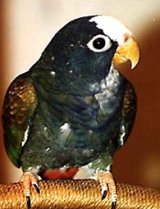
Care should be taken to avoid human infection and spread of chlamydia to unexposed birds. Protective clothes, shoes and a face mask should be worn around infected birds. These clothes and shoes should not be worn when handling other birds. Caretakers should wash or shower immediately after caring for exposed and infected birds. Because Psittacosis is spread by aerosolization from infected feces and respiratory secretions, wearing a face mask will decrease exposure to the infective particles. Waste materials should be disposed of appropriately so that the environment is not contaminated.
During treatment, the aviary should be disinfected several times to minimize re-exposure to chlamydia. Once a bird recovers, it is susceptible to re-infection.
Stress must be minimized in the infected bird or flock. If breeding is occurring, it must be stopped. Any concurrent disease must be treated. IF medicated pellets are to be used, the bird should be converted to a pelleted diet if not already on one.
Tetracyline or Doxycycline is used to treat chlamydiosis. These drugs alter the replication of the organism. Both drugs are successful only when the organism is metabolically active or dividing. They are not affective when a bird is latently infected in which case the organism is inert in the macrophage. Since chlamydia psittaci can remain dormant in cells, a treatment period of 45 days is necessary.
Shedding of chlamydia is thought to cease eithin the first two weeks of treatment.
Several treatment regimes exist Selection of the treatment method depends upon the applicable public health regulations, the ability of the owner to medicate the bird and which regime the bird will accept. All regimes other than CTC medicated food are considered “experimental” and may not be permitted by public health regulatory officers in certain parts of the U.S.
Collections may be treated with medicated food while individual birds may be treated by injections or oral suspensions.
Chlortetracyline (CTC) medicated food may be fed as the only source of food. Small birds – such as budgies, canaries and finches – may readily consume medicated seed and millet. Larger birds often do not accept the medicated diet because the pellets and mash are often perceived as foreign. Even birds accustomed to pelletes may refuse the medicated pellets since they are somewhat bitter. Ill birds may not eat and thus not receive any medication. If the pellets aren’t adequately consumed, insufficient antibiotic blood levels occur, resulting in treatment failure and continued shedding of chlamydia.
Doxycycline, a semisynthetic tetracylcine derivative may be used to treat psittacosis. It is far superior because it is more lipophlic and more completely absorbed from thr gastrointestinal tract. It accumulates at high levels in the tissues and remains for longer periods of time in the body than tetracycline.
Vibravenos is a Dutch intramuscular formation of Doxycycline. It is givrn weekly for several weeks and then at five day intervals for 45 days. It is very effective and can be given by the veterinarian. The disadvantage is that it is costly and not easily obtained.
Doxycycline may also be administered orally as a suspension. This is effective if the owner can handle the bird and administer this directly into the beak.
Baytril seems to aleviate clinical signs, but seldom clears the birds of infections.
Combination treatment may be employed. If a bird is very ill. it may be started on intramuscular or oral Doxycycline and once stable, switched to oral medication.

